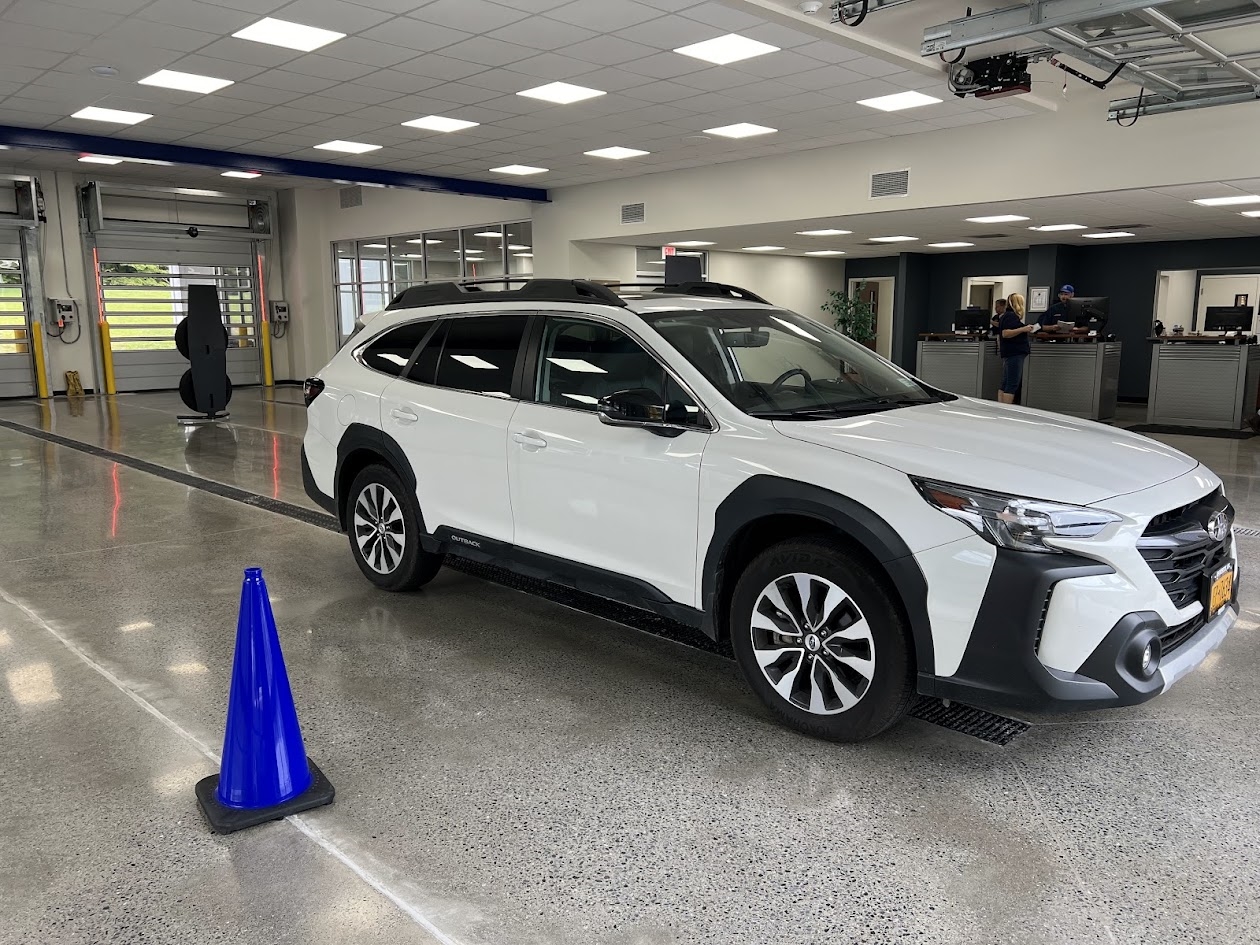Subaru Service in Rhinebeck, NY
Welcome to Our New Service Center!
This summer after 55 years of servicing Subarus in the village, we are now open with a new state-of-the-art service center right near the Kingston-Rhinecliff Bridge. It’s all the same Ruge’s family you know and love in a new home with the best of everything. You’ll enjoy the same competitive pricing, free shuttle to and from the village and express service with no appointment necessary, so get ready to visit us at our new service location, right on 9G in Rhinebeck!
Directions to the New Location:3718 Route 9G, Rhinebeck, NY







FAQs
Our new service center is conveniently located at 3718 Route 9G in Rhinebeck, NY. We are about 2.5 miles from the Kingston-Rhinecliff bridge, and 2.5 miles up the road from our previous location in the Village of Rhinebeck. Our sales showroom is still located in the Village of Rhinebeck.
All the same services are available, from regular maintenance like oil changes and tire rotations to more complex work! We are also pleased to offer the Express Lane Service! Express service has it's own pull-through lane where you can come by for an oil change and tire rotation with no appointment necessary!
Although we specialize in all Subaru makes and models, we have the ability to service almost every other make and model. Our Subaru Certified Technicians have decades of experience and look forward to keeping your Subaru up and running for many years to come!
To schedule your appointment, simply click on "Schedule Service" on our website, or call in for availability. With our new faciility, we are able to service our customer's vehicles much quicker to get you on the road faster! Keep in mind, for "Subaru Express Service" (oil change and tire rotation), you don't need an appointment at all, just come on by and pull into our Express lane garage door.
Our Service hours are
Sunday:CLOSED
Monday:7:30 AM - 6:00 PM
Tuesday:7:30 AM - 6:00 PM
Wednesday:7:30 AM - 6:00 PM
Thursday:7:30 AM - 6:00 PM
Friday:7:30 AM - 6:00 PM
Saturday:7:00 AM - 3:00 PM
Yes! We are happy to provide a running shuttle to and from town so you can enjoy all the coffee shops, restuarants and shops right in the Village of Rhinebeck. Our shuttle runs from the Service Center on Monday-Friday starting at 8am. The shuttle stops at the Sales Location in the village of Rhinebeck and returns on the half hour.
The last shuttle from the Service Center leaves at 3:00pm, and the last return shuttle from the Sales location is at 4:30pm. On Saturdays the shuttle runs from 8:00am-2pm.
Yes, we will offer after hours drop off! You can park in the customer parking lot off to the side and put keys in the after-hours drop box.
We do offer loaner cars for longer services, based on availability. If you require a loaner vehicle, please schedule your service appointment ahead of time and verify availability!
We offer service specials, discounts and coupons. They can always be found on our specials page on rugessubaru.com
Yes! We have a very comfortable waiting area, with work stations, Wi-Fi, coffee, and snacks!
We'd love for you to share your experience online after your visit! After your visit you will receive a link so you can easily leave a review us on Google!
No! We are pleased to offer the same pricing as our current location!
A History of Service Excellence
Ruge’s Subaru is the leading Subaru dealership in Rhinebeck, a reputation we’ve continuously built for nearly a century. Our passion for helping customers maintain their vehicles is integral to our history. Joseph Ruge brought his automotive dreams to life in 1935 when he opened a one-pump Sunoco fueling station and a limited repair shop in Rhinebeck. Three years later, he expanded that dream and moved into a three-bay garage, laying the foundation for his future as one of the community’s most beloved automotive dealers.
What It Means to Choose Us
The Ruge name quickly became synonymous with excellence, and that’s a tradition we’re proud to continue. Like Joseph set out to do in the mid-1930s by treating everyone like family, we believe our customers deserve an unparalleled experience rooted in transparency, integrity, and respect. These values define every aspect of who we are and guarantee the same excellent service, whether you’re working with our sales team or relying on the expertise of our factory-trained technicians. But why else should you choose Ruge’s Subaru for all your automotive maintenance and repair needs?
We Have Industry-Wide Expertise
One of the many reasons to choose Ruge’s Subaru is because there’s no make, model, or automotive issue that we can’t handle. Our industry-wide expertise means our services are comprehensive and include everything from routine oil and filter changes to fluid flushes, battery checks, multi-point inspections, tune-ups, tire rotations, wheel alignments, brake repairs, and more. These services are available to every customer, whether you drive a best-selling Subaru like the Outback or another make and model from brands like Honda, Chevrolet, Toyota, or GMC.
We Only Hire the Best
Joseph Ruge knew the importance of investing in his team so they could readily meet the needs of customers throughout the Rhinebeck community. That lesson defines our efforts to hire only the best technicians to run our service center and reinvest in their ongoing education and training so that they can more readily serve customers like you. Among the Ruge’s Subaru team are certified Subaru technicians that know the ins and outs of the Subaru lineup and are constantly honing their skills to keep up with the newest Subaru models and industry trends.
A State-of-the-Art Service Center
Our state-of-the-art service center mitigates the inconvenience that often comes when your vehicle is in for routine service or repair. For example, local garages or other service departments don’t keep fully stocked inventories, which means there’s a significant delay between getting parts, making the necessary repairs, and getting back on the road. Fortunately, we don’t believe customers should have to wait any longer than necessary.
Our certified technicians have all the necessary tools and equipment in the service center. Likewise, our in-house parts department has a vast selection of genuine Subaru parts and accessories available to our technicians and customers. This availability gives you access to high-quality parts at affordable prices, whether you’re changing the oil in your Subaru from the comfort of your garage, adding a roof rack, or tackling another car-related DIY project at home.
We Stock Genuine Subaru Parts
What does it mean to maintain a vehicle’s integrity? Many service departments rely on aftermarket parts to cut costs and save time. However, this compromises the vehicle's integrity because an aftermarket or generalized part isn’t made for a specific make or model. It’s considered a one-size-fits-most, which can affect your vehicle's performance.
We don’t believe in cutting corners, so we make it easy to maintain your Subaru’s integrity by offering genuine Subaru parts in Rhinebeck, NY. These parts are made specifically for the Subaru fleet and help keep your Subaru a Subaru. In turn, you reap the benefits of knowing your Subaru is running its best with high-quality parts.
We Save You Money
We know that maintaining your vehicle can be expensive, especially if you need an unexpected repair and haven’t had ample time to save. We’re here to minimize these expenses as much as possible by offering a variety of service specials that can reduce the cost of these services or the price of parts. With these specials constantly rotating, there’s always an offer that can keep more of your hard-earned money in your wallet.
We Value Your Time
Bringing your vehicle in for maintenance can be time-consuming, particularly the appointment-scheduling process. Service centers are often hectic, with constantly ringing phones and a parade of technicians, customer service representatives, and customers coming in and out throughout the day. This hubbub can make it overwhelming or challenging to schedule an appointment over the phone, especially if you’re pressed for time.
Ruge’s Subaru values your time and is here to help make the entire process easier. For example, you don’t have to call the dealership to schedule an appointment. Instead, you can schedule your appointment online from the convenience of your home, office, or wherever you are. Even better is that the tool is available 24 hours a day, 365 days a year, which means you never have to wait!
We Make the Wait Enjoyable
We do everything possible to make your experience at Ruge’s Subaru enjoyable, whether you’re buying a new model or bringing your vehicle in for service. Joseph Ruge set the standard for this customer-centric approach, and we’re here to take it one step further. We make the wait enjoyable.
Our service center lobby is designed with you in mind. As you wait for your vehicle, we want you to make the most out of your time. So you’ll find plush seating and free WiFi that makes it easy for you to catch up on work, emails, or your favorite show. We also offer complimentary coffee, snacks, and water. We even have a kids' corner to help little ones pass the time.
Let Ruge’s Subaru Help Protect Your Investment
Ruge’s Subaru is the fulfillment of a dream that started in 1935 when a young entrepreneur opened a garage and fueling station to serve the Rhinebeck community. That young entrepreneur made a lasting impression on his customers, treating them each as part of the family and establishing his reputation for delivering big brand sophistication and small-town values. Today, Ruge’s Subaru continues that tradition, offering a small-town feel with big-brand appeal.
You’ll experience this incredible tradition firsthand when you put your vehicle in the trusted hands of the technicians that run our state-of-the-art service center. We’re here to help you protect your investment, offering industry-wide expertise that guarantees no job is too big or small. Ruge’s Subaru can handle it all, giving customers like you the confidence of knowing our team always has you covered wherever the road takes you.
If you’re ready to experience this for yourself and join the Ruge’s Subaru legacy, we encourage you to stop by the dealership at 6444 Montgomery Street and meet the team. You can also give us a call or schedule a service appointment online. Just remember that whatever you need, Ruge’s Subaru is here to deliver.
Service Specials

Wild Card Special




